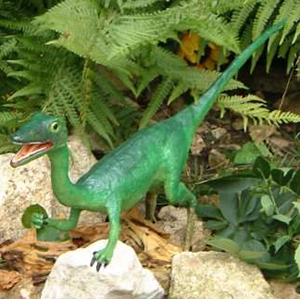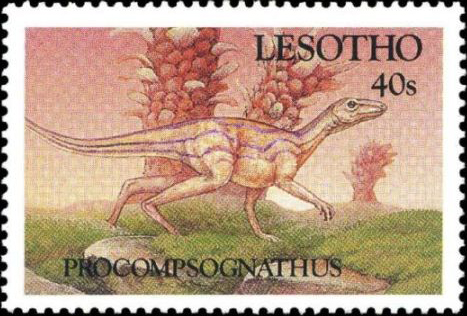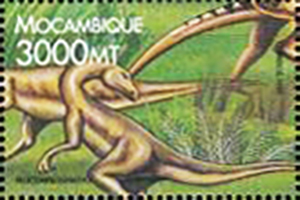Procompsognathus triassicus Fraas, 1913

(Da: it.wikipedia.org)
Phylum: Chordata Haeckel, 1874
Subphylum: Vertebrata Cuvier, 1812
Classe: Dinosauria Owen, 1841
Ordine: Saurischia Seeley, 1887
Famiglia: Coelophysidae Nopcsa, 1923
Genere: Procompsognathus Fraas, 1913
Descrizione
Il nome del genere significa “prima di Compsognathus”, altro dinosauro il cui nome a sua volta significa "mascella elegante"; dal greco antico kompsos ossia elegante raffinato o delicato e gnathos che significa "mascella". Il prefisso Pro significa "prima" o "antenato", sebbene non vi sia alcuna prova di parentela tra i due generi. Il nome specifico, triassicus, si riferisce al periodo geologico in cui visse l'animale. Il Procompsognathus è uno dei più piccoli dinosauri mai esistiti che da adulto poteva raggiungere il 1 m di lunghezza, anche se Fraas (1913) ha stimato una lunghezza di 75 cm. Nel 2010, Gregory S. Paul stimò un peso di 1 kg per una lunghezza di 1,1 m. Il Procompsognathus era bipede con lunghe gambe sottili e braccia più corte. Il muso era lungo ed esile con piccoli denti, e una coda rigida che bilanciava il peso del corpo. Il femore, scoperto insieme all'esemplare tipo, misurava 93 mm e la tibia 112 mm. La tibia è di circa il 20% più lunga del femore, un adattamento fortemente correlato con lo sviluppo delle abitudini cursorie, suggerendo che questi animali erano buoni corridori. Il Procompsognathus viveva in un ambiente relativamente asciutto, verso l'interno dove date le dimensioni cacciava e si nutriva di insetti, lucertole e altre piccole prede. Tra gli animali contemporanei vi erano i coelophysoidi Halticosaurus e Dolichosuchus, i sauropodomorphi Plateosaurus e Efraasia.
Diffusione
Genere estinto di dinosauro teropode coelophyside vissuto nel Triassico superiore, circa 210 milioni di anni fa (Norico), in Germania.
Bibliografia
–E. Fraas. 1907. Aetosaurus crassicauda n. sp. nebst Beobachtungen über das Becken der Aetosaurier [Aetosaurus crassicauda n. sp. together with observations on the pelvis of aetosaurs]. Mitteilungen aus dem Königlichen Naturalien-Kabinett zu Stuttgart 42: 101-109.
–Knoll, F., 2008, "On the Procompsognathus postcranium (Late Triassic, Germany)", Geobios 41: 779-786.
–Fraas, E., 1911, "Die schwäbische Dinosaurier", Jahreshefte des Vereins für vaterländische Naturkunde in Württemberg 1912: LXVI-LXVII.
–Pompeckj, J.F., 1915, "Zur Erinnerung an Eberhard Fraas und an sein Werk", Jahreshefte des Vereins für vaterländische Naturkunde in Württemberg 1924: XXXIII.
–Fraas, E., 1913, "Die neuesten Dinosaurierfunde in der schwäbischen Trias", Naturwissenschaften 1(45): 1097-1100.
–Von Huene, F., 1921, "Neue Pseudosuchier und Coelurosaurier aus dem württembergischen Keuper", Acta Zoologica 2: 329-403.
–Liddell, Henry George and Robert Scott (1980). A Greek-English Lexicon (Abridged ed.). United Kingdom: Oxford University Press.
–Holtz, Thomas R. Jr. (2011) Dinosaurs: The Most Complete, Up-to-Date Encyclopedia for Dinosaur Lovers of All Ages, Winter 2010 Appendix.
–Paul, G.S., 2010, The Princeton Field Guide to Dinosaurs, Princeton University Press p. 72.
–Molina-Pérez & Larramendi 2016. Récords y curiosidades de los dinosaurios Terópodos y otros dinosauromorfos, Larousse. Barcelona, Spain p. 23.
–Coombs, W. P., Jr. 1978. Theoretical aspects of cursorial adaptations in dinosaurs. The Quarterly Review of Biology 53: 393-418.
–von Huene, F., 1932, Die fossile Reptil-Ordnung Saurischia, ihre Entwicklung und Geschichte. Monographien für Geologie und Paläontologie, 4, pp. 361.
–Sereno, Paul C.; Wild, Rupert (December 15, 1992). "Procompsognathus: theropod, "thecodont" or both?". Journal of Vertebrate Paleontology. 12 (4): 435-458.
–Chatterjee, S., 1993, "Procompsognathus from the Triassic of Germany is not a crocodylomorph", Journal of Vertebrate Paleontology 13(3): 29.
–Chatterjee, S., 1998, "Reassessment of the Procompsognathus skull", p. 6 in: Wolberg, D.L., Gittis, K., Miller, S., Carey, L., and A. Raynor (eds.), Dinofest International. The Academy of Natural Sciences, Philadelphia.
–P. C. Sereno. 1997. The origin and evolution of dinosaurs. Annual Review of Earth and Planetary Sciences 25:435-489.
–M. D. Ezcurra and F. E. Novas. 2007. Phylogenetic relationships of the Triassic theropod Zupaysaurus rougieri from NW Argentina. Historical Biology 19 (1): 35-72.
–Carrano, M.T., Hutchinson, J.R., & Sampson, S.D. 2005. New information on Segisaurus halli, a small theropod dinosaur from the Early Jurassic of Arizona. Journal of Vertebrate Paleontology 25(4): 835-849.
–Knoll, F. & Schoch, R., 2006, "Does Procompsognathus have a head? Systematics of an enigmatic Triassic taxon", Journal of Vertebrate Paleontology 26: 86°.
–Knoll, F. & Schoch, R., 2012, "CT scanning, rapid prototyping and re-examination of a partial skull of a basal crocodylomorph from the Late Triassic of Germany", Swiss Journal of Geosciences 105: 109-115.
–Rauhut, O. and Hungerbuhler, A. (2000). "A review of European Triassic theropods." Gaia 15, 75-88.
–Carrano, M.T, Hutchinson, J.R, Sampson, S.D. (2005). "New information on Segisaurus halli, a small theropod dinosaur from the Early Jurassic of Arizona." Journal of Vertebrate Paleontology. 25 (4):835-849.
–Allen, D. (2004). "The phylogenetic status of Procompsognathus revisited." Journal of Vertebrate Paleontology, 24 (3): 34°.
–Frances Freedman & Tony Gibbons, 1997, Looking at-- Procompsognathus: a dinosaur from the Triassic period, Gareth Stevens Pub., 1 January 1997, pp. 24.
–Baden-Wurrtemberg, Germany; 1. Lower Stubensandstein," in Weishampel, et al. (2004). Page 524.
–Bennington, J Bret (1996). "Errors in the Movie "Jurassic Park"". American Paleontologist. 4 (2): 4-7.

|
Data: 09/06/1992
Emissione: Animali preistorici Stato: Lesotho |
|---|

|
Data: 28/04/2000
Emissione: Animali preistorici Stato: Mozambique |
|---|